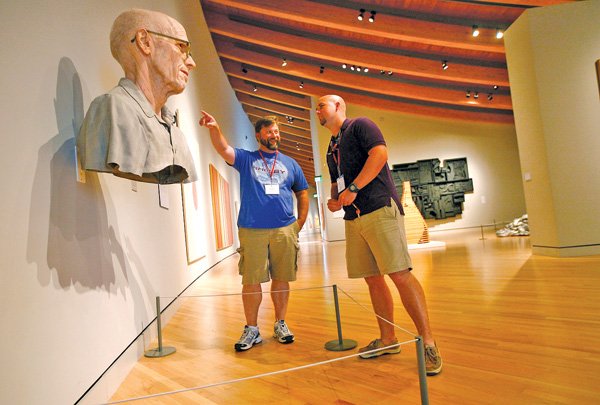BENTONVILLE — Teachers take field trips, too.
A group of about 50 Advanced Placement history teachers toured the Crystal Bridges Museum of American Art on Wednesday seeking inspiration on how best to incorporate art into lesson plans.
They were there as part of the University of Arkansas Honors College’s AP Summer Institute, a four-day program in which teachers receive training from consultants, who have extensive experience teaching in the various AP subject areas. The consultants come to the institute from across the country.
At A Glance
AP Summer Institute
The University of Arkansas has offered an Advanced Placement Summer Institute for teachers for about 15 years. This year it offered 18 courses with about 300 middle and high school teachers participating. About 275 of those teachers are from Arkansas. AP teachers are required to get 30 hours of training every five years; they are required to get additional training whenever the curriculum for their particular subject area is changed.
Source: Staff report
Marsha Gray-Scholze, a retired teacher from Denton, Texas, is leading the training this week for about two dozen experienced AP history teachers. She instructed her teachers to browse through Crystal Bridges’ exhibit halls and find a piece of art that spoke to them on one of four themes: diversity, national identity, the economy, and cultural shifts.
“One thing I always incorporated in my history classes was how art reflects history,” Gray-Scholze said. “We can see shifts in art that directly parallel what’s happened in our nation’s history.”
Charles Foster, who teaches at West Memphis High School, zeroed in on “Winter Scene in Brooklyn,” an 1820 painting by Francis Guy, as a piece that represented the nation’s identity at the time.
“I’m excited to get back and share this with all my students,” Foster said.
David Miller, an AP history teacher from Westside High School in Jonesboro, snapped dozens of pictures while strolling through the museum.
Miller said he discusses “Kindred Spirits,” an 1849 painting by Asher Brown Durand, in his class every year. The landscape painting is one of the most well known in Crystal Bridges’ collection.
“To see the real thing is exciting,” Miller said.
Miller uses what’s presented in textbooks as a starting point for talking about art history, he said. His students also research art online.
“If it wasn’t five hours away, I’d be bringing my kids (to Crystal Bridges) to see the real thing,” Miller said.
Aaron Hinterthuer and his students will be much closer to the museum. Hinterthuer is entering his third year in education and his first year teaching AP history at West Fork High School, less than an hour south of Crystal Bridges.
“It’s a major advantage to be able to come to a place where you can see the art up close rather than in a book,” Hinterthuer said. “It’s a big difference.”
Paul Shaddox, an AP history teacher from Broken Arrow, Okla., is another one of the consultants at this summer’s institute. He asked teachers to formulate a document-based essay question — a staple of AP history tests — using a piece of art they found in the museum.
“It’s basically to encourage the teachers to bring their kids to places like this to show them how art is connected with U.S. history,” Shaddox said.
Classroom discussions of art can be engaging for some students, he said.
“We have a lot of students who are very artistically inclined,” Shaddox said. “Anything we can do that appeals to their interests has to be helpful to us.”

